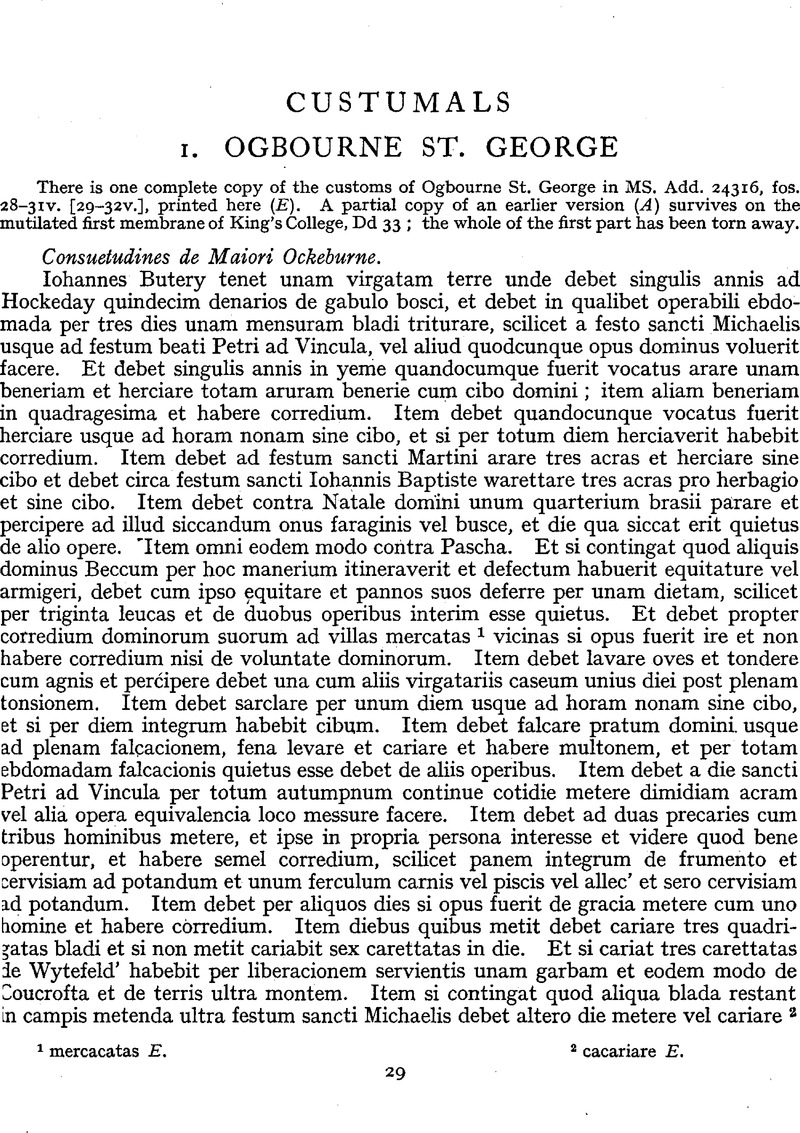No CrossRef data available.
Article contents
I. Ogbourne St. George
Published online by Cambridge University Press: 24 December 2009
Abstract

- Type
- Custumals
- Information
- Copyright
- Copyright © Royal Historical Society 1951
References
1 mercacatas E.
2 cacariare E.
page 38 note 1 Of the twenty-two virgate and half virgate holders enumerated eight are different in C and twenty in B and E.
page 39 note 1 The names of the crofters imply some trade ; Jordanus Parmentarius is succeeded by Henricus Parmentarius, Rogerus Taillur by Petrus le Burgeys, and Editha vidua tixtoris by William le Webbe.
page 42 note 1 Cheeses were sent annually from England to Bee (English Lands of Bee, p. 42).
page 56 note 1 Chisenbury lay within the parish of Enford (Hoare, Modern Wiltshire, ii. 17).
page 57 note 1 A hamlet adjacent to Chisenbury, on the south-west.
page 57 note 2 Lord of the neighbouring manor of West Chisenbury or Chisenbury de la Folly.
1 The Thursday before Good Friday.
1 The earl of Leicester.
1 1300–1.
1 It is noteworthy that the Hundred Rolls describe the virgaters as ‘serfs holding 8 acres each, making 2½ virgates altogether’, implying that the unit here is the small pastoral virgate. To the local officials the virgate was a unit of tenure whatever its size; to the royal officials it was becoming a standard measure of 32 acres.
page 94 note 1 Sic. Presumably the reference is to services now Due from another tenement.
page 96 note 1 For maltsilver, see N. Neilson, Customary Rents, p. 36.
page 96 note 2 Cf. the customs of the tenants of Wickham, Essex (Domesday of St. Paul's, pp. Ixxiv, 37). The account rolls of Blakenham show no trace of the growing of flax at the end of the thirteenth century.
page 97 note 1 Cf. a slightly later copy of the customs in Rotuli Hundredorum, ii. 837. Whereas the number of customary virgates is the same in both, far fewer cottars are enumerated in the Hundred Rolls; a fact suggesting the incompleteness of the royal record.
page 97 note 2 In the Hundred Rolls the abbot of Bee held half a virgate of Ralph de Thar.
page 98 note 1 Still holding the same tenement in the Hundred Rolls. By that time the only other free tenant of the abbot of Bee was John White, who held four virgates for suit of court.
page 99 note 1 The abbot of St. Evroult had surrendered the patronage of the church to Bee (English Lands of Bee, p. 144).
1 This reference to churchscot modifies the statement of Miss Neilson (Customary Rents, p. 194), that there are no clear cases of it in East Anglia. Cf. also an apparent reference to churchscot at Lessingham (supra, p. 106).
1 The leasing of these tithes was not an invariable practice : in the Pipe Roll of 1288–9 the bailiff of Bledlow accounted for the sale of tithe corn from Waddesdon. Infra, p. 130.




